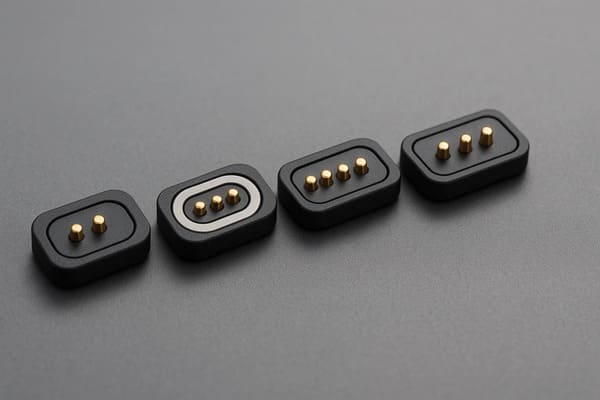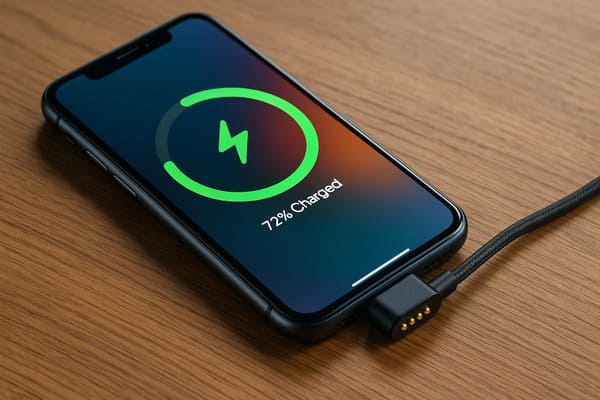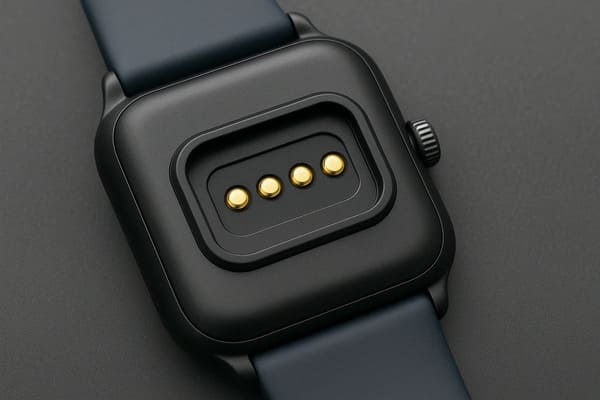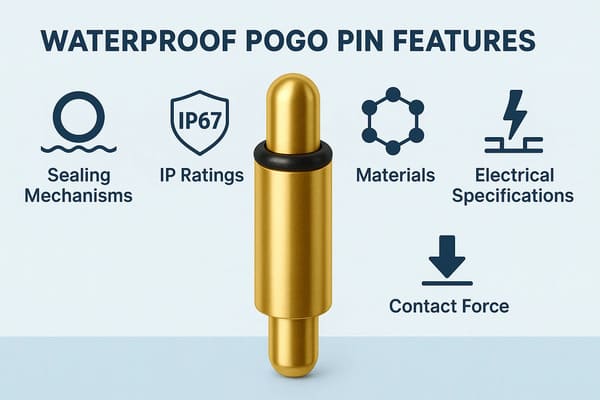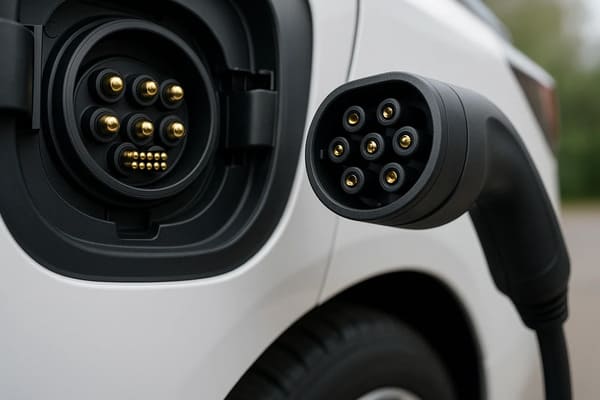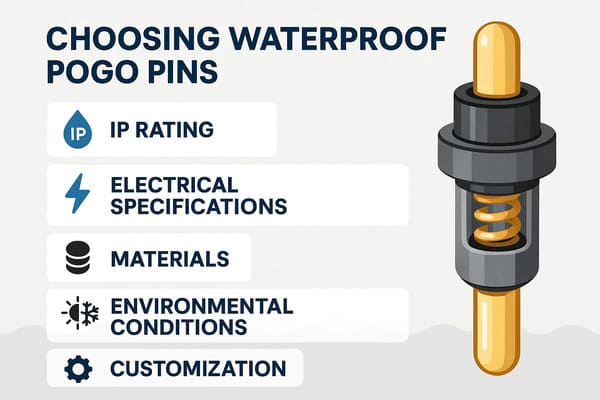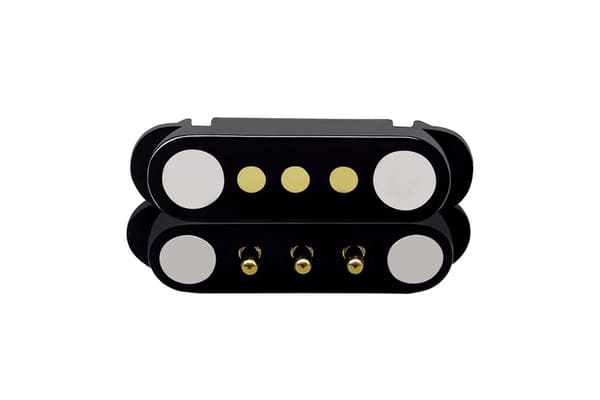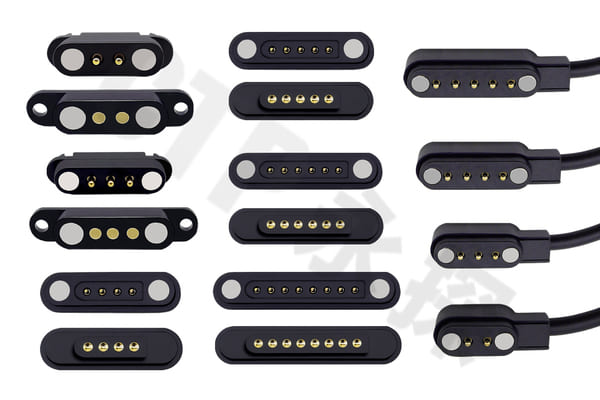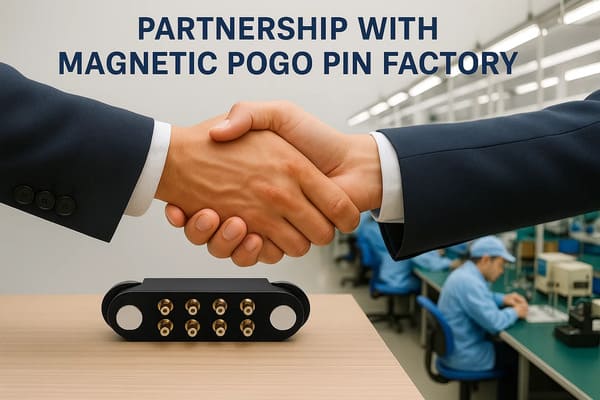Ever wondered if pogo pins can withstand water and harsh environments?
Dive into this critical question as we uncover their potential for your toughest applications!
Pogo pins themselves are generally not waterproof. However, specialized designs and connectors, often rated to standards like IP68, offer robust water and environmental sealing. These sealed options are crucial for reliable performance in harsh conditions, ensuring durability for demanding applications.
Curious about how waterproof pogo pins work and where they excel?
Stick with us as we delve deeper into their construction, applications, and the best environmentally sealed solutions available.
Understanding Pogo Pins
Pogo pins, also known as spring-loaded connectors, are essential components in electronic devices, providing reliable electrical connections between circuit boards or conductive surfaces.
These versatile components are utilized across various industries, including:
- Consumer Electronics: Smartphones, tablets, and wearables for charging and data transfer.
- Automotive: Electric vehicle (EV) charging systems and on-board electronics.
- Medical Devices: Portable monitors and wearable health equipment.
- Industrial and IoT: Sensors, robotics, and smart home devices.
Standard pogo pins are not designed for waterproofing.
Their open structure, often made of brass or stainless steel, allows moisture to enter, which can lead to corrosion or electrical issues.
Specialized waterproof pogo pins have been developed to address the needs of devices in harsh environments.
The Necessity of Waterproof Pogo Pins
Many electronic devices function in environments where moisture is a concern, necessitating robust solutions for connectivity.
For instance, designers of waterproof fitness trackers require connectors that can endure sweat and rain without failing.
In demanding applications like electric vehicle (EV) charging stations, which must operate reliably in humid or rainy conditions, waterproof pogo pins are essential.
They ensure consistent performance and prevent issues such as corrosion or electrical failure caused by moisture ingress, crucial for maintaining device integrity in challenging environments.
Without waterproofing, standard pogo pins face significant risks:
- Corrosion: Moisture degrades metal components, reducing conductivity.
- Electrical Failure: Water ingress causes short circuits or insulation breakdown.
- Device Malfunction: Unreliable connections lead to performance issues or failure.
Waterproof pogo pins incorporate sealing mechanisms and materials to prevent water entry, ensuring long-term reliability.
These connectors are essential for maintaining device performance in challenging conditions.
Are Pogo Pins Inherently Waterproof?
Standard pogo pins are not designed with inherent waterproofing.
Their open structure leaves them vulnerable to water intrusion, which can lead to damage and unreliable connections in wet environments.
Pogo pins are not inherently waterproof.
Their design typically lacks protection against water ingress, making them vulnerable in wet conditions.
However, many pogo pin manufacturers offer advanced waterproof pogo pin designs, featuring silicone or rubber seals and IP ratings like IP67.
These allow for temporary immersion without compromising performance.
These specialized pogo pins can withstand challenging conditions, offering reliable electrical connections.
They are crucial for devices used outdoors or in humid environments.
Types and Features of Waterproof Pogo Pins
Pogo pins are essential for many electronic devices, providing reliable electrical connections.
Their design—consisting of a barrel, plunger, and spring—ensures consistent contact even with slight misalignment, making them versatile components across various applications.
Waterproof pogo pins take this reliability a step further.
They feature specialized seals that protect internal components from dust and liquid, making them ideal for harsh environments.
These pins can achieve IP ratings like IP67, which signifies protection against submersion.
This makes them critical for devices exposed to moisture, ensuring both durability and reliable performance.
Understanding the fundamental design principles of waterproof pogo pins is crucial for appreciating their effectiveness.
These components incorporate specific features that enable their resilience in challenging environments.
Design Features of Waterproof Pogo Pins
Waterproof pogo pins are designed to resist water and maintain electrical integrity.
Their precision-engineered construction incorporates several key features to ensure reliable performance in challenging environments:
- Sealing Mechanisms: Silicone or rubber seals, like O-rings, prevent water from entering the connector’s barrel.
- IP Ratings: Indicate protection levels against dust and water:
- IP67: Dust-tight and protected against immersion up to 1 meter for 30 minutes.
- IPX7: Protected against immersion up to 1 meter for 30 minutes.
- IPX8: Suitable for continuous immersion beyond 1 meter.
- Materials: Gold plating ensures corrosion resistance; brass or stainless steel provides durability.
- Electrical Specifications: Support voltages up to 12Vdc, currents up to 10A, and low contact resistance (50mΩ maximum).
- Contact Force: Ranges from 40g to 175g for stable connections.
- Durability: Rated for 20,000 to 100,000 mating cycles.
Leading Suppliers of Waterproof Pogo Pins
When considering waterproof pogo pins, several manufacturers offer robust solutions.
These companies provide connectors designed for challenging environments, focusing on durability and reliable performance.
Their products often feature advanced sealing methods and corrosion resistance:
- CTP (Shenzhen Yongtan Electronics Co., Ltd.): IP67-rated through-hole pogo pins with silicone seals, gold-plated components, 12Vdc, 10A capacity, 175g ±20g contact force, and 20,000-cycle lifespan.
- CFE: Customizable waterproof pogo pins with enhanced sealing for automotive and medical applications.
- Promax Pogo Pin: Connectors for automotive and industrial use, featuring proprietary seals and corrosion-resistant materials.
- Yokowo: IPX7-rated connectors using potting or O-rings, tested with air leak machines.
- Zhenghe Precision Electronics: SMT/DIP waterproof pogo pins with 10.2mm height, 1.5mm diameter, and 5µ” gold plating.
The following table compares these features:
| Feature | Description | Example Specification |
|---|---|---|
| IP Rating | Protection against water and dust | IP67, IPX7, IPX8 |
| Material | Base metal and plating for corrosion resistance | Gold-plated brass, stainless steel |
| Electrical Rating | Voltage, current, and resistance capacity | 12Vdc, 10A, max 50mΩ |
| Contact Force | Force for stable contact | 175g ±20g at 1.8mm displacement |
| Durability | Number of mating cycles | 20,000 cycles |
| Mounting Type | Attachment method | SMT, THT |
In conclusion, understanding the diverse features and benefits of waterproof pogo pins is crucial for selection.
Prioritize providers demonstrating expertise in sealing mechanisms, material science, and rigorous testing for optimal performance in demanding applications.
Applications of Waterproof Pogo Pins
Waterproof pogo pins offer robust connectivity solutions across various industries.
Their design ensures reliable electrical contact, even in challenging environments where moisture and dust are present.
These connectors are essential for maintaining performance and longevity in diverse applications.
Waterproof pogo pin connectors provide reliable electrical connections in moisture-prone environments.
They are used in consumer electronics like smartphones and wearables, medical devices for secure data transmission, and the automotive industry.
Industrial machinery also employs these connectors for consistent electrical connections in challenging conditions.
Waterproof pogo pins are vital in industries where moisture exposure is common.
They ensure reliable connections despite challenging environmental conditions.
Key applications include:
- Consumer Electronics: Smartphones and wearables need connectors for charging in wet conditions.
- Automotive: EV charging interfaces and sensors require waterproofing for outdoor use.
- Medical Devices: Portable monitors and health equipment must withstand cleaning fluids.
- Industrial and IoT: Sensors and robotics in humid environments rely on sealed connectors.
- Marine: Navigation systems use IPX8-rated pogo pins to resist saltwater corrosion.
Waterproof pogo pins are crucial for maintaining reliable connections across many sectors.
Their design ensures devices function effectively in challenging, moisture-prone environments, enhancing both durability and performance.
Selecting the Right Waterproof Pogo Pin
Choosing the right waterproof pogo pin requires careful consideration.
Selecting appropriate components ensures optimal performance and longevity in various applications.
Key factors help guide this decision:
- IP Rating: Select IP67 for temporary immersion or IPX8 for continuous submersion.
- Electrical Specifications: Ensure support for required voltage, current, and resistance (e.g., 10A for EV charging).
- Materials: Gold-plated pins suit corrosive environments; stainless steel offers durability.
- Environmental Conditions: Assess exposure to humidity, salt, or chemicals. Marine applications need high salt spray resistance.
- Customization: For unique designs, choose a supplier offering tailored solutions.
Testing samples is essential for new designs.
Many providers can offer samples to support prototyping and validation efforts, helping ensure the chosen components meet specific project needs.
Latest Trends in Waterproof Pogo Pins
The increasing demand for reliable electronic devices in various environments has driven significant advancements in waterproof pogo pin technology.
Understanding these developments is crucial for anyone involved in product design and manufacturing.
key trends in this area include:
- Miniaturization: Compact connectors for smaller devices maintain waterproofing.
- Higher IP Ratings: IPX8 or IP69K connectors cater to extreme conditions.
- Advanced Materials: New coatings enhance durability and environmental resistance.
- Smart Integration: Connectors support high-frequency data transfer for IoT devices.
Continued innovation is focused on meeting these evolving requirements.
Custom solutions are often developed to address the specific needs of various applications, ensuring optimal performance and reliability.
Case Studies and Real-World Examples
Waterproof pogo pins have demonstrated their reliability across diverse applications.
Examining these real-world scenarios offers valuable insights into their practical benefits and performance characteristics.
- Smartphone Charging: A smartphone manufacturer used IP67-rated pogo pins for waterproof charging ports.
These connectors ensured performance in rain, lasting 20,000 cycles and reducing warranty claims. - Medical Glucose Monitors: A medical firm integrated IPX7-rated pogo pins into glucose monitors, withstanding disinfectant cleaning over 50,000 cycles.
- Industrial Automation: A robotics company used waterproof pogo pins for sensors in humid factories, ensuring 30,000 cycles of stable data transfer.
These examples underscore the critical importance of rigorous testing and careful material selection.
Such considerations are paramount to ensuring optimal and long-lasting performance in any given application.
Conclusion
Standard pogo pins are not waterproof, but specialized IP68 and IPX7/IPX8 versions offer robust protection for moisture-prone environments.
At CTP, our high-quality waterproof pogo pins ensure reliable performance.
Contact us via our contact page for personalized assistance.

